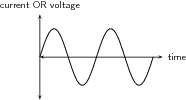| << Chapter < Page | Chapter >> Page > |
Most students learning about electricity begin with what is known as direct current (DC), which is electricity flowing in a constant direction. DC is the kind of electricity made by a battery, with definite positive and negative terminals.
However, we have seen that the electricity produced by some generators alternates and is therefore known as alternating current (AC). The main advantage to AC is that the voltage can be changed using transformers. That means that the voltage can be stepped up at power stations to a very high voltage so that electrical energy can be transmitted along power lines at low current and therefore experience low energy loss due to heating. The voltage can then be stepped down for use in buildings and street lights.
In South Africa alternating current is generated at a frequency of 50 Hz.
The circuit symbol for alternating current is:

Graphs of voltage against time and current against time for an AC circuit are shown in [link]

In an ideal DC circuit the current and voltage are constant. In an AC circuit the current and voltage vary with time. The value of the current or voltage at any specific time is called the instantaneous current or voltage and is calculated as follows:
is the instantaneous current. is the maximum current. is the instantaneous voltage. is the maximum voltage. is the frequency of the AC and is the time at which the instantaneous current or voltage is being calculated.
The average value we use for AC is known as the root mean square (rms) average. This is defined as:
Since AC varies sinusoidally, with as much positive as negative, doing a straight average would get you zero for the average voltage. The rms value by-passes this problem.
Capacitors and inductors are found in many circuits. Capacitors store an electric field, and are used as temporary power sources as well as to minimize power fluctuations in major circuits. Inductors work in conjunction with capacitors for electrical signal processing. Here we explain the physics and applications of both.
You have learnt about capacitance and capacitors in Grade 11.
In this section you will learn about capacitance in an AC circuit. A capacitor in an AC circuit has reactance . Reactance in an AC circuit plays a similar role to resistance in a DC circuit. The reactance of a capacitor is defined as:
where is the capacitance and is the AC frequency.
If we examine the equation for the reactance of a capacitor, we see that the frequency is in the denominator. Therefore, when the frequency is low, the capacitive reactance is very high. This is why a capacitor blocks the flow of DC and low frequency AC because its reactance increases with decreasing frequency.

Notification Switch
Would you like to follow the 'Siyavula textbooks: grade 12 physical science' conversation and receive update notifications?